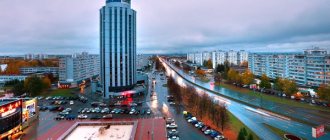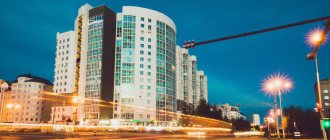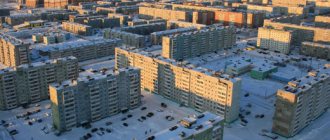History of conferring the honorary title “City of Military Glory”
Since its founding in 1584, the city of Arkhangelsk has been and remains a northern outpost of Russia, making a significant contribution to the formation and development of the military power of the Fatherland, the formation of glorious military traditions of the Armed Forces and the Navy.
Arkhangelsk is the first military seaport of Russia, in which, at the shipyards created by the Decree of Peter I, the planned construction and launching of military and commercial ships, which at that time formed the basis of the Russian fleet, began.
In the military clash of 1701, the Arkhangelsk garrison did not allow the passage of the Swedish military expedition deep into Russia, thereby securing the Northern Sea Route to Moscow.
For more than 120 years, Arkhangelsk has been a large shipyard, providing the Russian fleet with military vessels of various tonnage and weapons, including battleships, frigates, fire ships and other auxiliary vessels.
The Arkhangelsk garrison took a direct part in the military operations to protect Arkhangelsk and the White Sea during the Crimean War of 1853-1856, showing examples of courage and heroism.
During the Great Patriotic War, Arkhangelsk, being essentially a front-line city, repeatedly bombed by German aircraft, was able to organize practical work to protect the northern borders of Russia and ensure the uninterrupted operation of the rear institutions of the army and navy.
On August 2, 1941, the People's Commissar of the Navy N.G. Kuznetsov made a decision to create the White Sea military flotilla in Arkhangelsk, which played a significant role in the defense and security of the White Sea military area.
During the war years, more than 700 allied transports passed in both directions in the flotilla zone, more than two million tons of cargo were transported for the USSR, and about 0.7 million tons of cargo were sent to the allies. More than 1,800 transports were escorted on internal communications.
The Arkhangelsk seaport handled 457,897 tons of cargo, including 1,360 tanks, 1,300 aircraft, 9,800 cars, 10,000 tons of rubber and other cargo of defense significance.
Scientists from Arkhangelsk made a number of discoveries that were important for the Armed Forces of the USSR:
- a flammable liquid was created to destroy enemy tanks;
- a special paste has been created to prevent freezing and fogging of optical instruments;
- native antibiotic penicillin was developed;
- A pine vitamin extract against scurvy has been created.
More than 120 northerners were awarded the title of Hero of the Soviet Union, 14 people became full holders of the Order of Glory.
The main attraction of the Russian North
250 kilometers northwest of Arkhangelsk are Solovki, an archipelago of six islands covered with forests, lakes and swamps. The main attraction of this archipelago and the entire Russian North is the Solovetsky Monastery.
Back in 1429, the first worship cross was installed on Solovki. A little later, two monks - Herman and Zosima - founded an Orthodox monastery here. At the very beginning, it consisted of just a few nondescript wooden buildings. But by the middle of the 16th century, the Solovetsky Monastery became the spiritual center of the entire Russian North.
For more than two centuries, the monastery also played the role of a prison in which opponents of the tsarist regime languished, and then enemies of Stalin. Many outstanding personalities passed through it: for example, comrades of the rebel Stepan Razin, the last ataman of the Zaporozhye Sich, Pyotr Kalnyshevsky.
Today the Solovetsky Monastery hosts travelers and tourists. By the way, this landmark can also be seen on the 500-ruble banknote.
The city during the Great Patriotic War
In 1942-1943, Arkhangelsk was subjected to massive bombing. During 1941-1945, about 40 thousand residents died in the city
During the Great Patriotic War, the White Sea military flotilla was based in Arkhangelsk. As in the First World War, the city was the main port through which aid arrived from Europe and America. During the war years, about 4 million tons of cargo passed through the Arkhangelsk seaport. The port received and unloaded more than 330 Soviet and foreign ships with strategic cargo. Important cargo for the front was sent from the city: timber, mortars, flamethrowers, snowmobiles.
Already on the first day of the war, the city committee of the CPSU (b) developed a set of measures to transform the life of the city in new conditions and began to implement them. Having merged with the military leadership of the city and region, he received emergency powers. With the beginning of the bombing of Arkhangelsk, this body officially acquired emergency status under the name City Defense Committee (GOKO) - a kind of representation of the State Defense Committee (GKO) in the North. Under his leadership, a restructuring of all levels of the city’s functioning took place according to the principle: everything that does not work for defense is inappropriate. Everything is for the front! Under this slogan, society seemed to be clenched into a single fist, the pyramid of power was sharpened, polished, taking the form of a formidable tip, strictly aimed towards the front.
This slogan was the basis for perestroika and the activities of all state and public organizations: parties, councils, Komsomol, trade unions, Osoaviakhim, and the Red Cross. Their structure and areas of activity were reduced to solving two main tasks: strengthening the city’s defense and helping the front in every possible way.
Strengthening the city's anti-aircraft defense, state and public organizations during the war years trained 11 thousand members of the anti-aircraft defense teams, more than 20 thousand for the newly created 122 self-defense groups, dozens of fire brigades and posts. Almost the entire population of Arkhangelsk has undergone training and retraining according to the “Ready for PWWW” standards. With the start of massive enemy air raids that followed in the summer and autumn of 1942, these measures made it possible to protect the city’s most important strategic objects from destruction and save many dozens of lives of citizens. Repelling these raids cost the city 150 dead and the same number wounded. These were mostly teenagers, many of whom, until the last flash of explosion in their eyes, seemed to be playing war, competing in the number of extinguished lighters. Without the air defense service there could have been many more casualties.
The defense of the city was an important area of activity for state and public organizations, but the primary focus throughout the war remained the mobilization of all forces and resources to provide all possible assistance to the front. In the first place in this work was the mobilization of townspeople to the front. In Arkhangelsk alone, over 30 thousand citizens voluntarily applied to join the people's militia, fighter battalions and partisan detachments, which amounted to 40 percent of Arkhangelsk residents called up during the war years. Even a quick glance at the names entered in the Book of Memory shows that more than half of the dead northerners did not return from the fronts at the beginning of the war, when volunteers made up the bulk of those mobilized. Poorly prepared, poorly armed, they were the first to die. The training of conscripts therefore became an important part of supplying the front with people. With the introduction of universal military training (Vsevobuch) on October 1, 1941, the entire adult population of the city underwent non-military training, acquiring military specialties - riflemen, machine gunners, machine gunners, snipers, tank crews. Almost all Arkhangelsk towns passed the GSO and BGSO standards, learning to provide first aid to the wounded. More than five thousand city women, in their free time from work or study, received the qualifications of nurses, sanitary assistants or medical instructors.
Hotels in Arkhangelsk
In the village there are many places where tourists can stay, from comfortable hotels to inexpensive hostels. The vast majority of hotels are concentrated in the city center, along Obvodny Canal, Lomonosov and Northern Dvina Embankment avenues.
Hostel "Northern"
In the Severny hostel for 900 rubles. You can rent a bed in one of the following rooms:
- 6-seater;
- 8-seater;
- 10-seater;
- 14-seater.
A place in a room with 4 beds will cost 950 rubles, and in a double room – 1050 rubles. For 2500 rub. You can rent the entire double room. There is a parking lot next to the hostel and free Wi-Fi. The rooms have the necessary furniture: beds, chairs, tables, lockers.
The bathroom and shower are located on the corridor, as is the shared kitchen for self-catering. Unlike most hotels, “Severny” is located some distance from the center, at the address: st. Galushina, 25. From the railway station you can get here by bus 64.
Hotel "Capital of Pomorie"
"Capital of Pomorie" is a business class hotel. Room prices here start from 3.4 thousand rubles. per night. For this amount you can rent a standard single room. The most expensive option - the presidential suite with an area of 140 m2 - costs 12 thousand rubles.
In addition to comfortable rooms, the hotel provides paid services:
- restaurant;
- sauna;
- billiards;
- conference hall.
The hotel address is Northern Dvina Embankment, 88. From the airport there is bus No. 12, from Arkhangelsk-Gorod station - No. 6, 54, 62.
Hotel "Pur-Navolok"
Near the “Capital of Pomorie” there is another premium hotel – “Pur-Navolok”. To rent a room for the night here costs from 4 thousand rubles. The price includes breakfast.
You can use the following services for free:
- storing valuables in a safe;
- luggage storage;
- trouser press;
- shoe cleaning;
- drying hair with a hairdryer;
- exercises in the gym.
Merits of the city in the military history of Russia
The contribution of the Arkhangelsk region to the defeat of the enemy is determined, first of all, by its labor resources.
With the outbreak of World War II, the role of Arkhangelsk again increased significantly. In the coalition strategy of the “peripheral war”, the city became the eastern point of the “Arctic Front” created by the Allies, from which in 1941-1942. it was planned to launch an offensive against Germany, and along which the main route for the supply of strategic cargo to the USSR ran.
From the first days of the Great Patriotic War, the city found itself in a front-line position. German planes circled over it almost every day. Only for June 1941 - June 1943. 465 enemy aircraft flights were recorded over the territory of the Arkhangelsk divisional air defense region. And in August-September 1942, with the arrival of the next PQ-18 caravan in the city, Arkhangelsk was subjected to massive bombing. During these months, 21,000 incendiary and 96 high-explosive bombs were dropped on the city. During the bombing, 130 houses were burned, 70 were destroyed. 86 people were killed, 112 were seriously injured.
Realizing the special importance of Arkhangelsk for the country, the State Defense Committee sent its authorized representative I.D. to Arkhangelsk. Papanin, and on September 14, 1942, a city defense committee was formed here under the chairmanship of the first secretary of the regional committee of the CPSU (b) G.P. Ogorodnikova. Such emergency authorities, as a rule, were created in front-line areas to organize the reflection of a possible enemy invasion.
In Arkhangelsk, to ensure the safety of navigation in the White, Barents and Kara Seas, on August 2, 1941, the White Sea Military Flotilla (BVF) was created, 90% of the ships of which were former civilian ships with Arkhangelsk crews. Thousands of residents of Arkhangelsk—merchant and fishing fleet sailors—actually found themselves on the front line of the “Arctic Front.” During the war years, 17 allied warships and 29 civilian ships were sunk in the BVF area of responsibility, 1,534 people were killed, including 737 military personnel and 793 Soviet civilians.
Together with sailors and port workers, river workers and railway workers of the city took part in the transportation of the most important goods. The speed of passage of tanks and aircraft to the front largely depended on the work of Arkhangelsk railway workers. Almost all 4 million cargoes processed at Arkhangelsk stations passed through without delays.
The river workers of the North did a huge amount of work. In war conditions, they had to relieve the load on more mobile railway transport as much as possible. And they succeeded quite well. During four military navigations, the vessels of the Northern River Shipping Company transported 21.6 million tons of cargo and 25.4 million passengers.
The uninterrupted operation of the Northern Basin fleet, the repair of warships and merchant ships, were designed to be ensured by eight ship repair and shipbuilding plants and shipyards in Arkhangelsk, the largest of which was Krasnaya Kuznitsa. Together with the logistics enterprises of the White Sea Military Flotilla, during the war years they returned 1012 ships to service and built more than 500 small vessels of the “mosquito fleet”. Along with their main activities, Arkhangelsk ship repairers carried out special government orders: for the production of armored snowmobiles, mine casings, bombs, grenades, and, since 1943, components of agricultural machines.
The importance of the Arkhangelsk transport hub, which sharply increased since the beginning of the war, somewhat displaced the place of the main timber processing complex in the economy of Arkhangelsk, which produced, it would seem, purely civilian products. But these products also found application in new conditions. The country used timber to pay off loans to its allies, provided along with gratuitous assistance. Timber was widely used in the construction of defensive lines, and from the middle of the war in restoration work.
Over 124 thousand tons of cellulose, 25 thousand tons of paper - this is the result of the work of Arkhangelsk paper workers during the war. Along with the main products, the city's factories produced thousands of tons of lime, hundreds of tons of turpentine, rope, soap and other wood chemical products. To the wood chemical products of wallets, it is necessary to add 300 tanks of alcohol and 750 of foundry concentrates sent for the needs of the front and defense industry by Arkhangelsk hydrolysis plants.
Local industrial enterprises and industrial cooperation companies produced products worth 118 million rubles. These products include camp kitchens and stoves, sleighs and carts, military equipment and uniforms. And the products made by the city's light industry factories - tunics, jackets, balaclavas, caps - were quite enough to equip a dozen full-blooded divisions.
With the outbreak of hostilities, Arkhangelsk became the closest rear of the Karelian Front, a front-line city. 31 evacuation hospitals were deployed here, for which the best buildings in the city were given over. There was a front-line evacuation point here (FEP-96). During the war years, 73% of the wounded and 90% of the sick were returned to duty.
The war required not only enormous human resources, but also large amounts of money to organize military production and preserve the financial system. Government loans and the cash and clothing lottery were intended to become the most important source of financing for military programs. Despite the heavy burden they placed on the city's population, 276 million rubles were transferred to the state budget from Arkhangelsk - an amount with which in those years it was possible to build 3,000 fighters or 1,300 tanks.
Moreover, Arkhangelsk residents became active participants in the creation of the People's Defense Fund. Over 47 million rubles in cash, 9.6 million rubles in bonds, more than 1 kilogram of gold, 41.5 kilograms of silver, 130 thousand items of warm clothing and shoes, 100 thousand pounds of potatoes, thousands of centners of meat, fish, and vegetables were donated by residents of Arkhangelsk to this fund .
Part of the assistance to the front of public organizations included sending gifts to soldiers of the Red Army, providing assistance to the families of military personnel, the wounded, disabled and orphans.
The names of 23,052 Arkhangelsk residents who died at the front are inscribed in the regional Book of Memory. Every third citizen drafted into the army, every tenth resident of pre-war Arkhangelsk did not return from the front. During 1941-1944, 38 thousand residents died in the city. Half of them occurred in the hungry and scurvy year of 1942. In fact, in terms of civilian mortality, Arkhangelsk was in second place after besieged Leningrad. And this despite the fact that thousands of tons of food passed through the Arkhangelsk port (!) With the lives of every fifth city dweller who died from hunger and disease, Arkhangelsk paid for Lend-Lease cargoes sent to the front in a timely manner, for built and repaired ships, for timber, pulp, fish - all that he could give to the country.
The military merits of Arkhangelsk residents were recognized at different times with government awards. On May 10, 1984, by decree of the Presidium of the Supreme Soviet of the USSR for his great contribution to the development of the navy, the development of the northern regions of the country, the merits of the city’s workers in the Great Patriotic War of 1941 - 1945, successes in economic and cultural construction and in connection with the 400th anniversary of Since its founding, the city of Arkhangelsk has been awarded the Order of Lenin.
May 4, 1985 in connection with the celebration of the 40th anniversary of Victory in the Great Patriotic War of 1941 - 1945. and for services in providing support to the Soviet Army and Navy during the Great Patriotic War of 1941 - 1945. By Decree of the Presidium of the Supreme Soviet of the USSR, the Arkhangelsk sea trade port was awarded the Order of the Patriotic War, 1st degree.
After 1945 and to this day, Arkhangelsk, as a warrior city, continues its constant watch, participating as the regional center of the Arkhangelsk region in solving the problems of the federal cosmodrome "Plesetsk", the federal nuclear shipbuilding center in Severodvinsk and the nuclear test site located on its territory on Novaya Zemlya.
The most significant military events associated with the city
On August 25, 1942, the sailors of the icebreaker "Alexander Sibiryakov", which was part of the icebreaker detachment of the White Sea Military Flotilla, accomplished a feat. Having entered into an unequal battle with the heavy German cruiser Admiral Scheer in the Kara Sea, the sailors, at the cost of their lives, saved a caravan of ships from destruction, preventing the destruction of several polar stations.
The sailors of the Northern Shipping Company vessels assigned to Arkhangelsk showed the highest resilience and heroism. During the war years, the shipping company lost 14 ships and more than 300 sailors while delivering strategic cargo. At the cost of their lives, Arkhangelsk sailors and Red Navy men, together with their allies, ensured the delivery of 4.2 million tons of cargo to Arkhangelsk, half of which was cargo sent by the allies under Lend-Lease. Among them are 2,312 aircraft, 3,428 tanks, 819 armored vehicles, 717 guns, 49 torpedo boats. It is appropriate to recall that by November 1942, about 900 tanks and a little more than a thousand aircraft were concentrated on the Soviet fronts to launch a counterattack at Stalingrad.
general information
The city is located in the northern region of the European half of Russia in the delta of the Northern Dvina River. The river flows into the White Sea 35 kilometers from Arkhangelsk. The terrain is flat, the height above sea level is seven meters. Along the river branches there are city embankments with a total length of 35 kilometers.
The area of the urban district is 29,442 hectares, the number of residents is 346,976 people (at the beginning of 2021).
From May 17 to July 26, white nights begin, and in winter you can see the northern lights.
The climate of the area is temperate maritime. Winters are long and moderately cold, summers are short and cool. The weather changes frequently, with many days with precipitation. Air temperature in winter can drop to -30°C, and in summer rise to +35°C.
Merits of the city's rear
The contribution of the Arkhangelsk region to the achievement of Victory is determined not only by the participation of its residents in hostilities. Their labor achievements are very significant; let us briefly recall some unforgettable deeds of the workers of the Arkhangelsk rear.
During the pre-war five-year plans, the region turned into a developed industrial region of the country. In 1940, it supplied the national economy with almost 16 million cubic meters of wood, 3.3 million cubic meters of lumber; Pulp and paper production, railway and sea transport received significant development.
In a short time, the region's economy was rebuilt on a war footing. The main workforce at the enterprises became women, teenagers, and pensioners, who replaced thousands of workers who went to the front. In the first three months alone, 5,200 women came to Arkhangelsk enterprises.
Sawmills received urgent orders for skis, sleds, ammunition caps, airfield and engineering equipment. During the war years, sawmills provided the front with over 3,200 thousand cubic meters of lumber, 15 million sets of special packaging, almost 20 thousand drag sledges and much more. Workers in the timber industry provided the country with more than 25 million cubic meters of wood and produced about 1,700 thousand guns and 360 thousand ski blanks.
Pulp and paper industry enterprises have mastered the production of gunpowder pulp and special grades of paper. The industry provided the country and the front with over 124 thousand tons of cellulose and 25 thousand tons of paper.
Ship repair enterprises in Arkhangelsk and Molotovsk converted civilian ships for military purposes and repaired warships and submarines. The team of ship repairers at Krasnaya Kuznitsa mastered the production of mortars, mines, grenades, and machine guns. He produced 213 snowmobiles, about 80 thousand mine bodies, and many other products.
The war radically changed the life of the northern village. Thousands of collective farmers went to defend their Motherland. They were replaced by women and teenagers who did everything to plow the fields, harvest the crops on time, and give the front more meat, oil, and grain.
At that time, the names of the Shenkur tractor driver A. Revina, the Kholmogory milkmaids A. Korobova, P. Yakovleva and many others were known throughout the region. During the war years, rural workers handed over to the state about 90 thousand tons of grain, 180 thousand tons of potatoes, more than 27 thousand tons of meat, and over 180 thousand tons of milk. Reindeer herders of the Nenets District sent over 4,000 reindeer to the Karelian Front to transport military cargo and wounded soldiers.
The workers of the Arkhangelsk seaport wrote a bright page in the chronicle of the war. In the first days of the war, the port received the responsible task of organizing the reception and processing of strategic cargo supplied under Lend-Lease from the USA and England. In the shortest possible time, the railway line Left Bank - the port of Economy was built, gantry cranes were installed, and dredging work was carried out. In winter, carriages were transported along a railway track laid on the ice of the Northern Dvina.
During the war, port workers accepted and promptly processed 332 vehicles, which delivered about two million tons of cargo. 2,312 aircraft, 3,428 tanks, 819 armored vehicles, many guns and other equipment left Arkhangelsk and Molotovsk for the front.
Teams of stevedores headed by N.D. Kuznetsov, M.A. Kolotov, S.A. Yanin, K.A. The Urpins, collapsing from fatigue, did not go home until the ships were completely unloaded.
The Motherland highly appreciated the work of the port workers. By decree of the Presidium of the Supreme Soviet of the USSR dated May 1, 1944, 296 people were awarded orders and medals.
The brave actions of the northern sailors will forever remain in the history of the region. From the first day of the war, the merchant fleet switched to working in a military manner. It was replenished with dozens of transport and fishing vessels transferred to Arkhangelsk from Murmansk, which was located in the zone of active enemy aviation.
The best sailors who had experience working in the Arctic were called up to serve in the fleet: Heroes of the Soviet Union M.P. Belousov and K.S. Badigin, as well as N.P. Annin, I.F. Kottsov, P.A. Ponomarev, N.I. Khromtsov and others.
Transportation of workers for the construction of defense fortifications in Karelia, transfer of military units, delivery of Norilsk and Pechora coal, nickel ore, evacuation of people and equipment from the front line, participation in export-import operations - this is not a complete list of the new tasks that fell on the shoulders of sailors of the North. Each of them involved a risk to life, each required endurance and courage. And on each of them the crews gave their all to the end.
The exploits of the crews of the icebreaker "Lenin" and the steamship "Alexander Sibiryakov", which entered into an unequal battle with the fascist heavy cruiser "Admiral Scheer", the patrol ships "Brilliant", "Passat", "Tuman", which died but did not lower the flag in front of enemy.
Almost 23 million tons of cargo were transported by the fleet of the Northern River Shipping Company. Dozens of its employees have been awarded orders and medals. Among them are captains A.A. Shchukin, M.L. Bryukhov, V.A. Raspopov and many others.
600 thousand centners of fish, so necessary for the front and rear, were obtained by the trawl fleet during the war.
The brave sailors of the Red Banner Northern Fleet and the White Sea Military Flotilla made a worthy contribution to the cause of Victory over the enemy. North Sea sailors destroyed about 260 enemy combat and transport ships, 1,300 aircraft, and provided escort for more than 4,000 transports.
Together with the 14th Army of the Karelian Front, the Northern Fleet stopped the German invaders on the Kola Peninsula. In October 1944, having launched a decisive offensive, the army and navy completely defeated selected German divisions and liberated Northern Norway from the occupiers.
The region's intelligentsia worked side by side with workers, office workers, and field workers during difficult years. Scientists, teachers, teachers, doctors, cultural and artistic workers provided great assistance to the front, trained specialists, participated in the training and education of the younger generation, and inspired people to work and feats of arms.
Health workers had to solve difficult problems. During wartime, Arkhangelsk became the rear hospital base of the Karelian Front.
The best buildings were given over to hospitals; first of all, new standard school buildings in Arkhangelsk, Kotlas, Nyandoma, and Molotovsk were adapted for them. By the end of the first year of the war, there were 31 hospitals with 14,280 beds in the region.
Many graduates of the Arkhangelsk Medical Institute worked as heads of hospitals and senior surgeons in hospitals. G.D. proved themselves to be skillful organizers of hospital services and doctors in those years. Orlov, S.I. Elizarovsky, V.A. Kazmin, N.V. Mikheev, dozens of other doctors and nurses.
One of the manifestations of caring for the wounded was donation, which became widespread during the war years. Donors K.P. saved many lives. Negodyaeva, A.V. Zheleznova, A.S. Sergeeva and many others who donated blood more than 30 times. There were over 17 thousand donors in the region, about 500 of them were awarded the “Honorary Donor of the USSR” badge.
But was the work of school teachers less important at that time? The names of many supporters of public education remain forever in people's memory. Honored school teachers of the RSFSR A.A. left a good mark. Vlasova, A.P. Aksel - director of school No. 37 in Arkhangelsk, T.P. Maltseva from Velsk, F.V. Semakov from the village. Rovdino and many others.
Car rental
To make it convenient to move around the Arkhangelsk region, you can rent a car.
Basic rental conditions:
- driver's age from 21 years, driving experience from 1 year;
- documents for concluding a contract - passport and driver’s license;
- the tariff does not include gasoline;
- the tariff includes: car rental, maintenance, insurance, seasonal tires;
- mileage limit per day - 250 km;
- rental period - at least one day.
The most popular rental companies are: My car rental, Rent avto, and Pilot. The rental price starts from 1000 rubles per day.
See train schedule here:
Military units and formations formed from the city population
On the eve of the war, the population of the region was 1 million 109 thousand. Of these, over 270 thousand people, or a quarter of the entire population of the region, were drafted into the army and to the front for all types of mobilization. More than 120 different military units were formed in the region: 3 rifle divisions, 5 separate rifle and ski brigades, the same number of separate regiments, 105 service units. To a large extent, residents of Arkhangelsk consisted of the 2nd Masurian, 23rd Guards Red Banner Dnovsko-Berlin, 28th Nevelskaya, 100th Lvov, 263rd Sivashskaya rifle divisions, 12th Red Banner Pechenga, 42nd, 63rd me and the 92nd Marine Brigade, many other units.
About 30 thousand people joined the ranks of the people's militia. Tens of thousands of citizens are mobilized for defense work. In the city, partisan detachments “Polarnik”, “Bolshevik” and “Stalinets” were formed and sent to the Karelian Front.
Nature
The natural areas of the Arkhangelsk region are diverse:
- Arctic deserts on the islands of Novaya Zemlya, Franz Josef Land and Victoria Island;
- tundra in the northeast;
- forest-tundra;
- The taiga with its forests occupies more than half of the territory.
The main part of the region's water bodies belongs to the sea basins of the Arctic Ocean.
The total length of the rivers is 250,660 km, the largest is the Northern Dvina and its tributaries: Vychegda, Mezen, Onega and Pechora. There are more than 74 thousand natural and artificial lakes in the region with a total area of over 0.01 km2, the largest: Lacha, Vozhe, Golodnaya Guba.
The flora is dominated by spruce trees, also pine trees, fir trees, larches, berry plants (strawberries, cloudberries, currants, raspberries, etc.), in the south there are many mushrooms (milk mushrooms, saffron milk mushrooms, porcini mushrooms and others), marshy plants and meadow grasses.
In the Arctic zone you can find: polar bears, reindeer, walruses, ringed seals, harp seals and bearded seals. Among the taiga inhabitants: moose, deer, bears, lynxes, wolverines, wolves, foxes, beavers, minks and others. Birds are represented in 300 species.
There are 113 specially protected natural areas in the Arkhangelsk region, namely:
- Pinega State Reserve;
- National parks: Kenozersky, Onega branch of Vodlozersky Park, Russian Arctic, Onega Pomorie;
- 34 reserves;
- 67 natural monuments;
- 2 dendrological gardens;
- 1 botanical garden;
- 4 protected areas.











